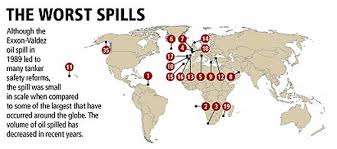Exxon Valdez Oil Spill
In 1973 Congress allowed
Trans-Alaska pipeline, making the oil to access crude oil from Alaska’s North
Slope. The oil companies then were able
to transport it to forty-eight states.
This meant big money for the companies but it also was a risk for Prince
William Sound because fisheries made up a huge part the economy. Alaska knew they wouldn’t be able to contain
the oil if something were to happen.
Knowing that if a large oil spill would happen they wouldn’t be able to
contain and it would result in long term consequences. The oil companies promised to use great care
when handling with the oil.
In 1989 an Exxon Tanker hit a reef
on the coast of Alaska in Prince William Sound.
Eleven of their cargo tanks ruptured allowing 10.8 million gallons of
oil to be expelled, which covered 11,000 miles.
But that’s before the storm came blowing the oil farther and more
widely. After all of that they
calculated that over 11,000 miles of coastline was contaminated. The captain Joseph Hazelwood admitted being
under the influence at the time of the incident. Exxon knew prior to the incident that
Hazelwood was a relapsed alcoholic. Even
after his license was taken way from driving under the influence they still
allowed him to take charge of the cargo tanks.
The Evening of March, 23 he had went into two bars for a couple of
drinks before getting on the ship.
The damage the oil spill caused many
of the animals living in that area to die off.
250,000 Sea Birds, 2,800 Sea Otters, 300 Harbor Seals, 250 Bald Eagles
and 22 Killer Whales. Not to mention
what damaged it caused the fish, something that drives their economy. The oil covered a national forest, four
wildfire refuges, three national parks, five state parks, four critical habitat
areas and a state game sanctuary. Ten
years after the disaster only twenty-three animal species that were injured had
made a full recovery.
For humans there isn’t any data on
the effects the oil spill had. But
cleanup workers have reported health problems that they have traced back to the
oil spill. The health problems that some
are experiencing in Alaska are the same that people have reported in the
Gulf. The symptoms include vomiting,
nausea, headache, stomach pains, chest pains, dizziness, and even possibly
dehydration and heat exhaustion. Many people
are still recovering from the oil spill just not physically but
emotionally. Many depended on fish as a
source of income for their families once the oil spilled it destroyed
them. Many of the fisherman just decided
it wasn’t worth staying there so they packed up and moved. Just so they wouldn’t be effected by the damages
of the oil spill.
The tourism industry lost over
260,000 jobs and over 2.4 billion in sales.
Alaska still hasn’t fully recovered because some vacationers think it is
still contaminated.



